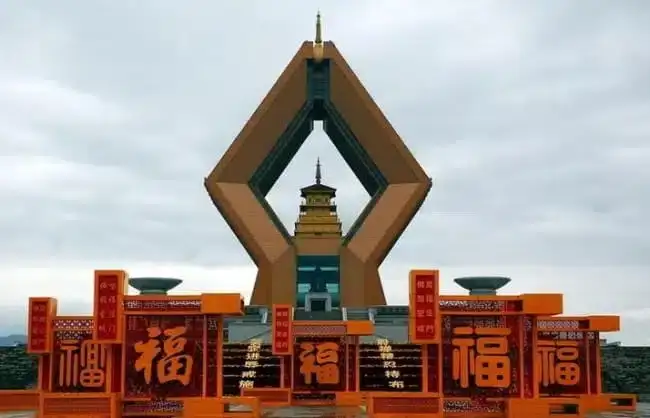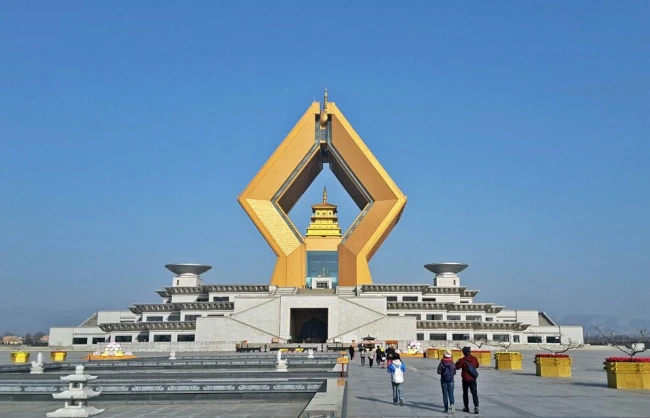Famen Temple: a Holy Buddhist Temple with the Sariras of Sakyamuni
Famen Temple (Famensi), located at Famen Town in Fufeng County, Baoji City, Shaanxi Province, is a famous temple for keeping the sariras of Sakyamuni Buddha. It has always been known as the initial monastery of all Buddhist monasteries in the Guanzhong Area, an important unit of cultural protection and preservation of the province, and a sacred place for making a pilgrimage tour in Xian.
Fast Facts about Temple Famen
- Type: Buddhist site, ancient architecture, museum
- Opening Hours: 8:30-17:30
- Entrance Fee: CNY100 per person (Mar. – Nov.) CNY90 per person (Dec. – Feb.)
- Time Needed: about 2-4 hours
- Best Seasons: All seasons
- Highlights: finger bone relic of Sakyamuni Buddha, unique pagoda and architecture style, rich cultural and Buddha relics collection
- Recommended for: Buddhism, history, culture, or architecture fans
- Location: Famen town, Fufeng County, Baoji City, Shaanxi Province; about 120 km from Xi’an.
History of Temple Famen
The Famen Temple, initially built under the reign of Emperor Huan of the Eastern Han Dynasty, has a history of over 1, 700 years. According to the “Record of Buddhist Classics”, to popularize Buddhism, King Asoka of Ancient India built 84, 000 stupas around the world for the separate keeping of the sariras of the Buddha, of which 19 were in China, and the Famen Temple was one of them. As kept underneath the pagoda were sariras of the Buddha, “the temple was therefore built and came to be known due to the existence of the the stupa.”
Renowned far and wide, the temple has by and by become a flourishing venue for pilgrims and one of great fame in the world. According to the historical record there were eight emperors in the Tang Dynasty who went to the temple taking the sariras back to the imperial palace for pious consecration and also granted a great many treasured objects to be kept in the crypt of the stupa.

In the long-run of its history the temple has experienced many a time of destruction and reconstruction. There used to have a wooden pagoda in the temple which due to long neglect collapsed after the earthquakes happened twice in Fengxiang area during the Ming Dynasty. The reconstruction of the pagoda made it a brick one of 13 storeys. The western half of it collapsed on August 24, 1981 and a crypt built in the Tang Dynasty was found on April 2, 1986 when archeologists were clearing up the base of the collapsed pagoda. The crypt, 21.4 meters long and covering a floor-space of 31.48 square meters, consists of a passageway, a platform, a tunnel and the front, middle and rear halls.
Highlights of Famen Temple
Relics from the Underground Palace
Discovered from the crypt (the Underground Palace) are a great number of cultural relics of the Tang Dynasty. They consists of two types: one being the figure-bone sariras of the Buddha and the other objects presented to the temple as contributions when the satires were escorted to and fro the imperial court for consecration. Most of the objects are gold-and-silver wares, pearls and jade-pieces, glazed wares, porcelains and silk and brocade, a total of over 900 pieces of treasured cultural relics. One of them is a 1.96-meter-tall Buddhist staff of four facades with silver-and-gold flower-motif decorations and 12 rings and carved on it are the two deities of Pratyeka.
The craftmanship is more exquisite and of higher grade than the brass-headed one, the largest of its kind now kept in Shosoin Treasure House in Japan. Still there are the gold-wire cassock and the embroidered skirt of Empress Wu Zetian. All of these are the precious treasure pieces very rare in the world. The excavation of the national treasures of real satires and some other articles have been considered as another important discovery after the Qin Terra-cotta Figures in the archeological field, a happy event in the Buddhist circles Chinese and foreign and in the world cultural history as well.
Since 1987, the Famen Temple Museum had been established to house the relics from the underground palace, offering visitors insights into the rich Buddhist heritage of the region.
.jpg)
Famen Temple
The renovated Famen Temple now presents an utterly new feature in the Famen Town and the towering brick pagoda, keeping the original style of the Ming Dynasty, has became a symbol of the temple. With worldly rare treasures on display the treasure pavilion is the main building if the museum with its profile quaintly shaped and its interior elegantly furnished. The layout of the temple compound remains the same as before with its pagoda standing in front of the Mahavira Hall in the style of the early Tang Dynasty. With corridors to link up the Brass Buddha Hall and the Mahavira Hall the pagoda for keeping the real remains, girdled in green, towers 47 meters high in the middle of the courtyard.
The whole spacious court presents a magnificent atmosphere in which the “surrounding corridors seem to be a girdle while the thrusting tower the piling up clouds. ” The glistening Mahavira Hall, splendidly reconstructed to set off the toweling pagoda, epitomizes in a livelier way the exquisite craftsmanship of the temple architecture as a whole. The newly-built Dharma-hall, abbot-cabinet, annexes on both sides and guesthouses intermingled with lush verdure in the compound suggest an ambience of “ a Buddhist world tucked deeply away in seclusion of flowers and plants.”
In front of the temple there is a big square and a broad access of stone-slates, which sides with green belts the pagoda road and the Chongzheng Road are neatly lined with betels, restaurants and shops and other set-ups in the service of tourists.

Namaste Dagoba
The Namaste Dagoba is a striking modern architecture designed by the renowned Taiwanese architect Li Zuyuan. This 148-meter-tall building was completed in 2009, resembling two hands pressed together in prayer. There is a pagoda-shaped structure in the center to house the relic of the Buddha’s finger bone.
In front of the Namaste Dagoba, Foguang Avenue stretches 1230 meters, connecting the temple gate with the pagoda square. The avenue is flanked by granite-carved colossal Buddha statues on either side, enhancing the spiritual ambiance of the entire site.

How to Get to Famen Temple
- Take a tourist bus from Big Wild Goose Pagoda West Gate or North Square, the bus ride takes about 2 hours.
- Take a high-speed train from Xi’an North Railway Station to Yangling South Railway Station which will take about 30 minutes, then take a taxi to the temple, the taxi ride will take about 35
- Take a long-distance bus from Xi’an West Coach Station to the temple directly which will take about 2 hours.
- Rend a car with driver from a local travel company. This is the most convenient option.
Travel Tips for Famen Temple:
- Next to the temple there is the Famen Temple Museum and the entrance fee is included in that of Famen Temple. Pay a visit there one will see lots of historical relics unearthed in underground palace in Famen Temple.
- It’s important to dress modestly to show respect for the Buddha and the deities. Avoid garments that expose too much skin .
- Maintain silence and observe the rules and regulations of the temple while inside. When encountering monks, greet them politely to show respect.
- Follow the designated rules regarding photography. Don’t take photos of Buddha statues and monks without permission. If necessary, seek guidance from temple staff.
Xian Tours including Famen Temple
- Famen Temple and Hanyangling Museum Day Tour
- Xian Qianling Mausoleum and Famen Temple Day Tour
- 7 Days Xian In-depth Tour
You can also contact our travel consultants to tailor make your Xian tours based on your preferences and requirements.









